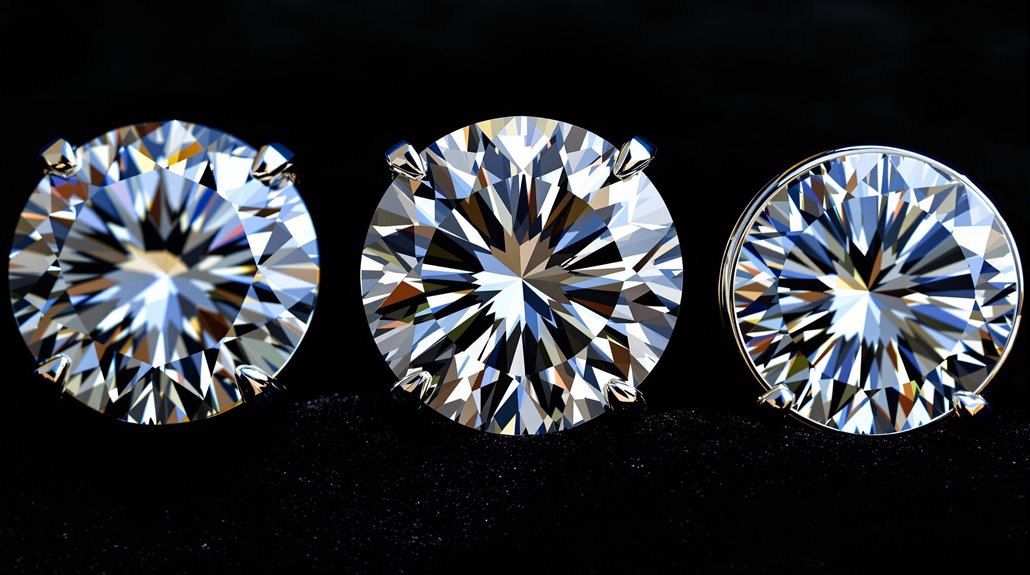Article Contents
- 1 Frequently Asked Questions
- 1.1 How Often Should I Have My Diamond Setting Professionally Checked for Security?
- 1.2 Can I Resize My Ring Without Damaging the Diamond Setting?
- 1.3 Which Setting Is Best for Protecting Diamonds During Everyday Wear?
- 1.4 Are Antique Diamond Settings More Valuable Than Modern Ones?
- 1.5 How Do I Clean My Diamond Ring Without Loosening the Setting?
Diamond settings serve as both protective architecture and aesthetic improvement for precious stones, fundamentally influencing their appearance and perceived value. The choice of metal and mounting style significantly affects how light interacts with the diamond, with white metals typically boosting brilliance as yellow or rose gold infuses warmth. From secure bezel settings to light-maximizing prong designs, each style brings distinct advantages in showcasing a diamond's natural beauty. The artistry of setting selection reveals deeper dimensions of fine jewelry design.
Every diamond's inherent beauty can be significantly amplified or subtly diminished by its setting, making the choice of mounting one of the most vital decisions in fine jewelry design. The metal influence of the setting plays a particularly important role, with the potential to alter a diamond's color perception by an entire grade. White metals, such as platinum and white gold, create a pristine backdrop that accentuates a diamond's natural brilliance and apparent whiteness. Conversely, yellow or rose gold settings infuse diamonds with a subtle warmth, creating an entirely different aesthetic experience. The light interaction between metal and stone creates a sophisticated interplay that connoisseurs have long appreciated. Platinum and titanium offer superior durability for protecting precious stones over time.
The architecture of a diamond setting deeply affects how light enters and exits the stone, directly impacting its brilliance and fire. Prong settings, revered for their classical elegance, allow maximum light exposure and create a heightened presentation that makes diamonds appear larger and more luminous. These settings have become a hallmark of fine jewelry, offering both aesthetic appeal and practical functionality. The positioning of prongs, carefully calculated to secure the stone while minimizing metal coverage, demonstrates the precision required in exceptional jewelry design. For optimal color enhancement, experts recommend using white gold prongs to minimize any unwanted color influences on the diamond. The diamond's appearance can be influenced by real world lighting more than studio conditions, making it essential to consider everyday wear scenarios.
Different setting styles serve distinct purposes in the realm of fine jewelry. Bezel settings, though they may slightly reduce a diamond's sparkle, offer superior protection and a sleek, contemporary aesthetic that appeals to those with active lifestyles. Halo settings create a magnificent display by surrounding the center stone with smaller diamonds, producing an improved appearance of size and brilliance that has captured the imagination of jewelry enthusiasts. Pavé settings guide the eye naturally to the center stone while adding a layer of sophistication and glamour to the overall design. The Art Deco style remains popular for those seeking geometric patterns and bold visual impact.
The selection of an appropriate setting requires careful consideration of multiple factors, including the diamond's cut, shape, and the wearer's lifestyle preferences. A well-chosen setting acts as both protector and enhancer, working in harmony with the diamond to create a piece that exceeds the sum of its parts.
The most successful designs achieve a delicate balance between security and showcase, guaranteeing the diamond remains both safe and spectacular. This sophisticated interplay between form and function exemplifies the artistry of fine jewelry design, where every element serves both an aesthetic and practical purpose. The ultimate goal remains consistent: to create a piece that not just preserves but also elevates the natural beauty of these remarkable treasures.
Frequently Asked Questions
How Often Should I Have My Diamond Setting Professionally Checked for Security?
Professional diamond security checks are recommended every six months for frequently worn rings and annually for occasional wear. Setting maintenance inspections should occur immediately after any impacts or accidents.
Can I Resize My Ring Without Damaging the Diamond Setting?
Time is of the essence when ring resizing. Professional jewelers can safely resize most rings during diamond protection, though success depends on the setting type and extent needed.
Which Setting Is Best for Protecting Diamonds During Everyday Wear?
Bezel settings offer superior protection compared to traditional prong settings, fully encasing the diamond during maintaining an elegant appearance. This secure choice remains popular among active professionals pursuing lasting protection.
Are Antique Diamond Settings More Valuable Than Modern Ones?
Antique diamond settings often command higher values owing to superior craftsmanship and historical significance, though their worth fluctuates with modern trends and market preferences in the collector's community.
How Do I Clean My Diamond Ring Without Loosening the Setting?
Safe diamond cleaning techniques include gentle soaking in mild dish soap solution, careful brushing with soft-bristled brush, and thorough rinsing ascertaining the drain is plugged to protect precious pieces.

